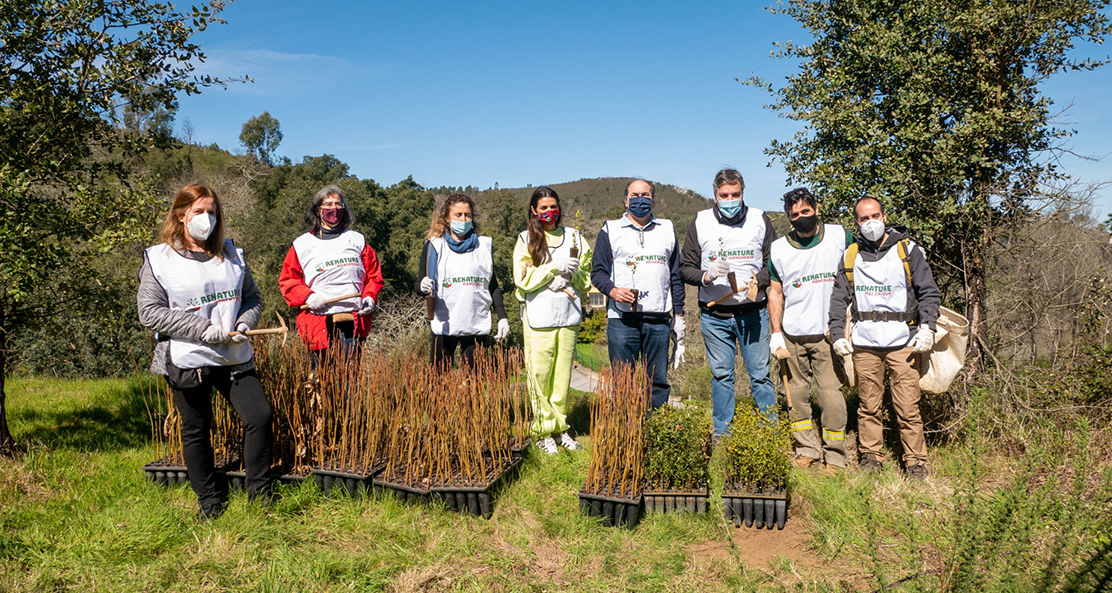By Suzanne Radford
The recovery of local trees and the restoration of the health of the land are the key drivers behind the Renature Monchique initiative.
The aim of the project is to replant endemic species in the Serra de Monchique, bringing a variety of oaks, including cork, Portuguese, Holm and the majestic Monchique oak, back to their natural home.
Now in its third phase, the project was initiated after the fires of 2018 in partnership with Ryanair’s Carbon Offset Fund, Tourism of Algarve, the Institute for Nature Conservation and Forests (ICNF), the Monchique Câmara and GEOTA, a national environmental NGO responsible for the coordination of the project. It’s a big undertaking but one that could help prevent fires in the future and allow for the natural biodiversity to return.
This area of the Algarve is a Natura 2000 site, part of the largest coordinated network of protected areas in the world and offering protection to Europe’s most valuable habitats. Known as the Monchique Natura 2000, the land contains some of the rarest, most unique and threatened species of the region – like the rhododendron and Monchique oak. There is replanting of oaks and trees like the strawberry tree or arbutus, which is fire resistant and provides a living for local producers of medronho and honey. Chestnuts that provide an income and more diverse endemic trees have been planted, along with the black alder and the narrow-leafed ash.
Ryanair has been involved from the beginning, with the company recognising Monchique specifically – and the Algarve generally – for its natural beauty: a destination which attracts large numbers of overseas visitors.
Thomas Fowler, Director of Sustainability at Ryanair says, “Renature Monchique sits within Ryannair’s carbon offset programme and is part of our commitment to reducing our CO2 emissions.” Contributions from Ryanair customers are helping to support the restoration of forest habitats affected by fire and climate change and, in so doing, they are also helping local communities.


To understand the carbon benefit associated with tree planting is to understand the value of the tree as a carbon sequester. Carbon sequestration is the process of capturing and storing carbon dioxide. It is a way of reducing the amount of carbon dioxide in the atmosphere we breathe and planting trees, improving degraded soils and habitats supports the natural processes of carbon sequestration, a recognised ecosystem service.
To date, over 135 000 trees have been planted on 52 plots of land, involving 40 landowners, including Sonia Carr Steyns of Mothers Finest Monchique, whose land was also affected by the fires. Sonia explains why she got involved. “We were never comfortable with the mono-culture and wanted to remove eucalyptus from our land. We were really pleased when GEOTA approached us regarding the Renature Monchique project with Ryanair. We not only received baby trees but the manpower to help plant them, and that’s around 300 trees so far.”
It is quite an undertaking, considering how many plots of land are spread across the mountains and, in many cases, with difficult access. Primarily locally based people have been employed to do the planting as they understand the terrain despite the sometimes adverse weather conditions.
Considering how long it takes for a tree to grow, 10 to 15 years for cork oaks and chestnuts and five to seven for the strawberry tree, one may wonder how long it will take before we begin to see the benefits. As I walk through the established tree groves and forests almost daily and breathe in the air, there is plenty to appreciate and gain right now from the existing endemic trees, but it would be short-sighted not to consider the wider implications. Justin Roborg-Söndergaard, Consultor de Projeto (GEOTA) explains that land stewardship is key. “As the Renature Monchique project develops, so does the notion that ecological restoration is important to the local and national social, economic, and ecological situation. This involves landowners, local communities and municipalities coming together to restore nature.”
Let us hope that by planting the seeds and acorns today, projects like Renature Monchique are creating a sustainable legacy and meeting future generations’ needs.













